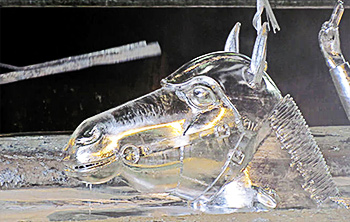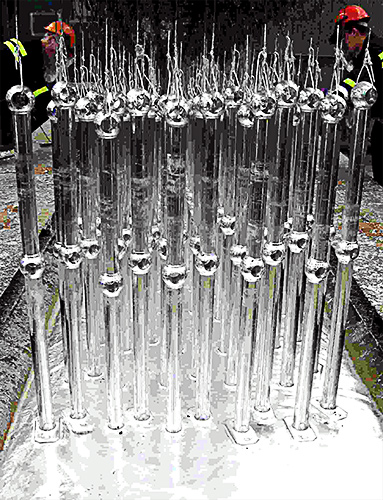Note: This article is the third of seven articles comparing methods of protective metal finishing processes.
Galvanization is one of the most common methods of protecting metals like iron or steel by applying a zinc coating. The zinc coating or galvanization helps protect the metal from corrosion and rust.
 The construction industry and steel container manufacturing use galvanized steel.
The construction industry and steel container manufacturing use galvanized steel.
The benefit of using this protection is that its low maintenance and repair costs are significantly lower than those of ungalvanized metal.
Without galvanizing, most commercially available steel wouldn’t be commercially viable.
Rust and corrosion would make long-term storage nearly impossible.
Also, rust builds up faster in some environments than others.
Luigi Galvani
 The time when a dead frog’s unexpected twitching became galvanization.
The time when a dead frog’s unexpected twitching became galvanization.
We derive the name Galvanization from Luigi Galvani (1737-1798), an Italian anatomist and physician. He investigated the phenomenon of bioelectrogenesis.
Around 1780, Galvani experimented by applying current to the muscles or nerves of frogs and other animals. He observed the current caused muscle contraction.
Those experiments used a Leyden jar or a rotating static electricity generator. However, an incident with a frog became famous.
In the strange case of Galvani’s frog, this twitching happened even when its legs were not in a direct circuit with the machine. Galvani had placed the lower section of a dissected frog on a table near a plate-type electrical machine.
Then two things occurred simultaneously, causing Galvani to stop and wonder. An assistant was drawing a spark from the brass conductor of the electrical machine when a knife held in his hand touched the crural or sciatic nerve passing through the lower part of the spine into the frog’s legs. There was an immediate twitch of the muscles and a kick of the legs as if a severe cramp had set in. Galvani wrote, “While one of those who were assisting me touched lightly, and by chance, the point of his scalpel to the internal crural nerves of the frog, suddenly all the muscles of its limbs were seen to be so contracted that they seemed to have fallen into tonic convulsions.
Trivia: Galvani’s work inspired Mary Shelley to write Frankenstein!
Protecting Iron and Steel
 Painting and powder coating are two of the most popular alternative methods of protecting steel and iron from rust. Yet, there are drawbacks to these methods.
Painting and powder coating are two of the most popular alternative methods of protecting steel and iron from rust. Yet, there are drawbacks to these methods.
When damaged, the coating on the steel peels off and rust forms. Once flaking starts, then the entire thing gets exposed. So, painting or powder coating doesn’t last long.
But, if e-coating the steel, an extra layer of protection prevents environmental exposure.
We've written an article explaining the e-coating process.
The two-coat process, including e-coating, provides greater protection from rust and corrosion over other metal finishing systems. Without having a base coat, any cracks or chips in the coating reduce the aesthetics and lifespan of that component.
Hot-dip galvanization is one of the most reliable ways to protect steel from corrosion.
When hot-dipped, molten zinc coats all surfaces, eliminating gaps where oxidization occurs.
While zinc corrodes, it does at a plodding pace. For this reason, galvanized steel lasts a very long time.
Also, when alloyed with iron, zinc, the result is cathodic protection. This protection limits exposure to the atmosphere and doesn’t compromise the steel.
 If rust forms in a small section of galvanized steel, it limits the damage by not causing any flaking of the zinc coating. It also means that damaged areas don’t need to be touched up like they have to with organic coatings.
If rust forms in a small section of galvanized steel, it limits the damage by not causing any flaking of the zinc coating. It also means that damaged areas don’t need to be touched up like they have to with organic coatings.
The cathodic protection lasts for as long as the layer of zinc isn't compromised.
Galvanization advantages include:
- No preparation time is needed before the process
- Cheaper long-term maintenance
- Longer life expectancy
- Higher ROI for businesses
- Reliable
- Withstands significant mechanical damage
Galvanizing Methods
There are several methods of galvanization, some more common than others. Each method has its advantages. As they say, your mileage may vary.
- Galvannealing
- Pre-Galvanizing
- Electrogalvanizing
Galvannealing
Galvannealing combines annealing with the hot-dip method, creating a specialized coating on the metal. After hot dipping, it’s now called galvannealed steel, a zinc and iron alloy.
Under a microscope, it isn’t hard to see the molten zinc formed a fusion with the steel, at least on the surface, creating a matte gray finish.
One good thing about galvannealing is the resulting product is very conductive for welding, and the surface is ideal for paint adhesion.
Pre-Galvanizing
The method is like hot-dip galvanizing, but it’s performed in the first production stage.
The process involves rolling the sheet metal through a highly effective cleaning agent and priming the metal for the procedure. The metal is then put into a pool of molten liquid zinc after its immediate removal.
Galvanizing many coils of sheets on an industrial scale is a significant advantage of this method.
The resulting coating is also more unified compared to traditional hot dipping. One advantage of using pre-galvanization is:
An advantage of this method is that large coils of steel sheet can be rapidly galvanized with a more uniform coating compared to hot-dip galvanizing. A disadvantage is that once fabrication of the pre-galvanized metal begins, exposed, uncoated areas will become present. This means that when a long coil of sheet is cut into smaller sizes, the edges where the metal is cut are left exposed.
Electrogalvanizing
Galvanizing steel is no more unique than electrogalvanizing—it doesn’t require dipping the metal in molten zinc. Instead, the method uses an electric current (similar to electroplating) introduced through an electrolyte solution.
After applying the current, positively charged zinc ions form a coating over the steel. Similar to pre-galvanizing, the method is used at the initial stage of production and applied continuously using a roll of sheet metal.
Some advantages of this process are a uniform coating and precise coating thickness. However, the coating is typically thinner than the coating of zinc achieved by the hot-dip galvanizing method which can result in reduced corrosion protection.
In Sum
Galvanization started over 300 years ago when an alchemist experimented by dumping clean iron into molten zinc. He was surprised by the resulting shimmering silver coating that ‘stuck’ to the metal. Today, finding examples of galvanized steel is easy.
- Bicycles
- Bolts
- Car Bodies
- Cool Rolled Steel
- Nuts
- Tools
- Wires
Looking at some buildings, balconies, staircases, ladders, verandas, and walkways all use galvanized steel.
If a fabricated metal project ends up outside, odds are it’s galvanized steel holding it together. Its popularity derives from its strength, durability, and corrosion protection.
To think, an accidental encounter between a scalpel and a frog’s nerve started the whole thing!